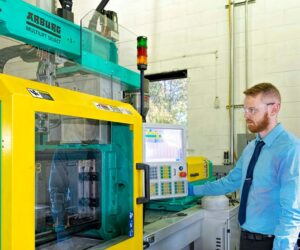Coinjection is an injection molding process in which different polymers are injected into the same mold to produce a specific effect. In many cases, the desired effects include changing the physical properties of the polymers or reducing production costs. This process is also known as sandwich molding. There are two types of coinjection processes: machine based and mold based. Each type offers its own specific advantages and applications.
Machine based coinjection requires the use of two or more processing units. This is considered a cold-runner process. The molten plastic of each processing unit is forced through a manifold where it is combined and then exits through a single nozzle. By processing the plastic through this means, the result is a core product covered by a skin of polymer.
Mold based coinjection is a hot-runner process in which the two molten plastics are kept separate until the last phase. The streams are joined when they reach the mold, forming a part with a dual layered effect. This type of molding is commonly seen in household products such as toothbrush handles that have a clear outer surface surrounding a colored core. While this application is suitable for creating certain aesthetic effects, it is also useful in other ways. The combination of a core product with an overlay of polymer allows manufacturers to create a wide variety of different properties for products.
The reduced cooling time required in the coinjection process makes this method a practical technique for low temperature core products. By using an inexpensive recycled core material coated with a more costly polymer skin, the manufacturer can save production costs. In a similar arrangement, a strong core material, such as glass, can be used to add strength and rigidity to a more flexible polymer. In some cases, coinjection molding is combined with a foam core to create products with sound absorption properties.
Aside from the obvious benefits to the manufacturing side of the process, coinjection offers advantages from a consumer and environmental standpoint, as well. This process makes recycling of plastic parts and post-industrial materials possible. These materials are ground and used to form inexpensive cores for injection molded parts. By using recycled materials, it lowers the cost to consumers and eliminates waste products in landfills. The strength added by core choices can also result in more durable, long-lasting products.
Read more: What is Coinjection?

